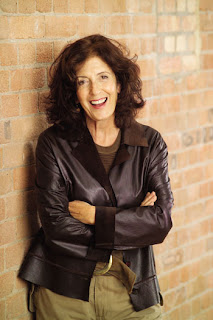 I thought that today I'd write about Anita Roddick the British entrepreneur, of Body Shop fame, who died last night.
I thought that today I'd write about Anita Roddick the British entrepreneur, of Body Shop fame, who died last night.
Though not about blogging it's interesting to look at the beginnings of successful businesses. Last year, for example, Body Shop was sold to L'Oreal for £652 million (about $1300 million) but when Anita started out things were very different.
When Anita Roddick set up her first shop in Brighton in 1976 she didn't want to change the world and she didn't even envisage herself as the entrepreneur she was to become. She simply wanted sufficient money to survive and to be able to feed her children.
Her husband had decided to take a couple of years off to fulfill a childhood dream. He wanted to ride a horse from Buenos Aries to New York, a distance of 5,300 miles. Goodness knows what a lot of wives would have said, but Anita accepted this and went about deciding on how she was going to support her family.
She hit upon the idea of starting a shop selling a small range of cosmetics, made from natural ingredients, in five different sizes and sold in the cheapest possible containers. She chose this idea because it was an irritation to her personally that she was unable to purchase small sizes of everyday cosmetics.
Anita was also aware that much of the money she was paying for products was being spent for fancy packaging, that she didn't want or need. Her personal grievances led her to a multi million company.
She recognised that if these things annoyed her then they must also annoy other women, and perhaps men as well.
Anita Roddick found her 'need' which she decided to fill. She didn't intentionally set out to buck the trend, she just recognised something that she thought people would want.
The idea of using natural ingredients developed from things that she had observed when traveling quite extensively prior to her marriage. When, for example, in Tahiti she noticed how the skin of even the elderly women remained soft, smooth and elastic despite constant exposure to the sun.
She found that the women used cocoa butter to rub into their skin. This had been practised for generations. The butter was an excellent skin conditioner and even prevented stretch marks during pregnancy.
Anita's travels also took her to Israel, Paris, Greece, Switzerland (where she worked for the U.N), Australia (where she sold weather boarding) and on to Madagascar, Mauritius and South Africa. As she travelled she observed things, such as the Tahitian cocoa butter, with no idea that they would prove invaluable to her in later life as a business woman.
The first Body Shop was started with the help of a £4,000 ($8,000) bank loan, though her first application for the money was actually turned down. She went to see the bank manager dressed in jeans and a T-shirt and was accompanied by her two small children. Despite her obvious enthusiasm the loan was declined.
This taught her a lesson that sometimes you have to conform. She got a friend to draw up a business plan, bought a business suit and tried again. She saw the same bank manager but this time got the money she needed. With her second application she went about it properly. Perhaps if she hadn't of been willing to change, in this instance, there may never have been the Body Shop empire of today.
 With the £4000 in her possession a shop was found in Kensington Gardens, Brighton. She painted the front and inside a dark green. This was no flash of inspiration but was chosen because it seemed the only colour that would cover the damp patches.
With the £4000 in her possession a shop was found in Kensington Gardens, Brighton. She painted the front and inside a dark green. This was no flash of inspiration but was chosen because it seemed the only colour that would cover the damp patches.The inside walls were covered with larchwood fencing and so the Body Shop basic image was born - out of necessity rather than some great preconceived plan. She did, however, lash out on having a logo designed, which cost her £25 ($50).
Everything for the first shop was done on a shoestring. Initially the ingredients were made up by herself. This caused a few problems so a flit through Yellow Pages found a herbalist who agreed to make up small quantities of the 25 products. The first order was for £700 ($1400) and was paid for in advance, out of the bank loan.
The cheapest containers to be found were small plastic bottles used by hospitals to collect urine samples! Handwritten labels were stuck onto the bottles and these were placed next to postcards giving descriptions and ingredients of the products.
As Anita couldn't afford sufficient bottles she decided to offer to refill used bottles or fill customers own containers. Recycling and reusing materials was born out of economical necessity more than a concern for the environment.
Go to Part 2
© Mike Perry 2007
Subscribe to Mike's Money Making Mission
Subscribe to Mike's Money Making Mission by Email
Source: Mike's Money Making Mission

No comments:
Post a Comment